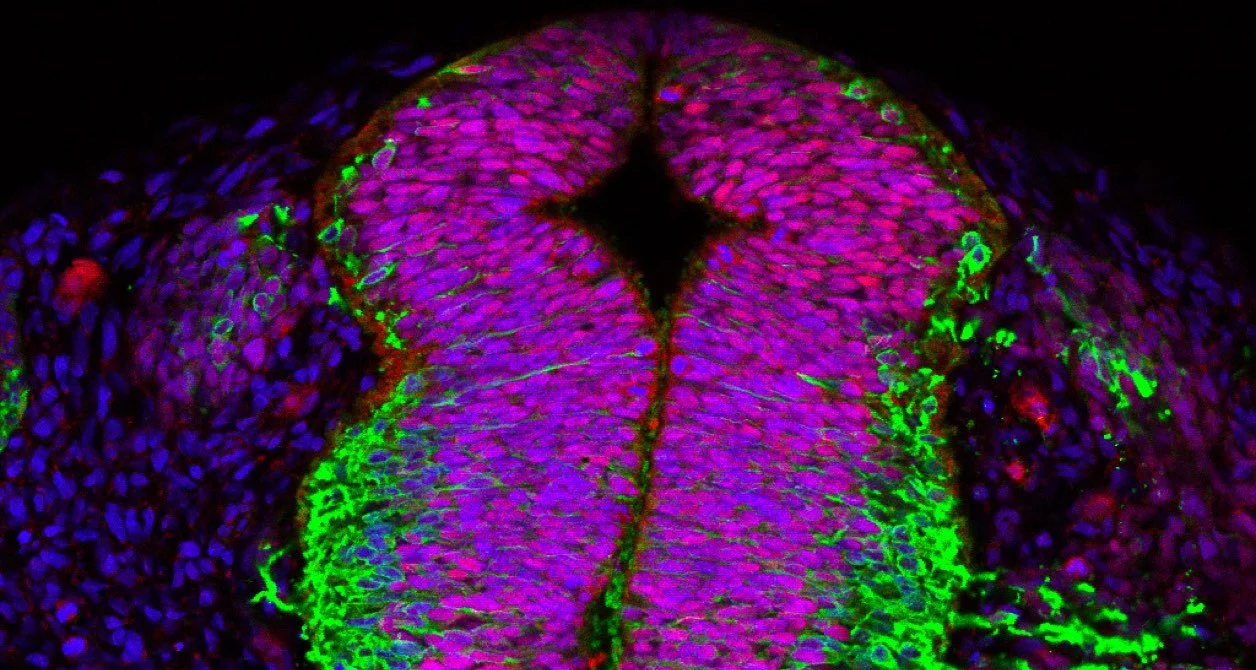
Neural Development
Studying how the central nervous system develops before birth
Background image: Precursors of neurons from the outer layer of the human developing brain (Image from the Long lab)
The brain makes us uniquely human. This theme will analyse how single stem cells form different parts of the brain, cerebellum and spinal cord.
We will focus on developing methods to grow and maintain embryonic and fetal brain, cerebellum and spinal cord tissue in the laboratory. This will allow us to track how cells grow and divide over time as well as performing genetic barcoding and analysing how and when genes are expressed in specific cells.
Neurons cells in the human upper spinal cord at 29-31 days of development (Image by Alwyn Dady, Storey lab: https://doi.org/10.7554/eLife.67283 ; HDBR Atlas, http://hdbratlas.org)

Differences in the cellular composition and connectivity of the brain underpin the cognitive capacity of humans.
Background image: Neurons in the human mid- and lower spinal cord at 29-31 days of development (Image by Alwyn Dady, Storey lab: https://doi.org/10.7554/eLife.67283 ; HDBR Atlas, http://hdbratlas.org
Specific qualitative and quantitative differences distinguish the developing human central nervous system (CNS) from other mammals, such as the presence of human-enriched or specific progenitor and neuronal types and differences in clone dynamics and behaviour, leading to the characteristic size, proportions and composition of the human CNS.
Methods to follow and infer the lineage relationship of cells within the developing CNS will allow us to address questions of how the large slowly developing human nervous system produces complex multicellular lineages in fixed temporal orders, while generating accurate numbers of each neuronal subtype. This will contribute to mechanistic understanding of the pathogenesis of neurodevelopmental disorders.

Members
-

Dr James Briscoe
We study how the spinal cord forms before birth and work towards understanding the fundamentals of how an embryo develops.
-

Dr Paula Alexandre
We study the cellular and molecular mechanisms that regulate neurogenesis and neuronal pattern in the brain and spinal cord. We use live imaging in developing zebrafish and human systems combined with histological and transcriptional analysis.
-

Prof Kate Storey
We investigate how the nervous system forms during embryonic development. Our aim is to discover cellular and molecular mechanisms that control neural differentiation. Elucidating these mechanisms helps us to understand better how the developing nervous system is impacted by cellular stress and may inform strategies for therapeutic treatment of neural injury and disease.
-

Prof Corinne Houart
King’s College London, Centre for Developmental Neurobiology
We study the molecular and cellular mechanisms that drive zebrafish forebrain development and the evolutionary mechanisms underlying vertebrate brain regionalisation.
-

Dr Katie Long
King’s College London, Centre for Developmental Neurobiology
Our research focuses on how the human neocortex develops with the correct size, shape and organisation, using human-tissue models to understand these processes.
-

Dr Giulia Boezio
(Briscoe lab)
-

Dr Gessica Gonçalves
(Houart & Long labs)
-

Dr José Rivera Álvarez
(Houart & Long labs)
-

Dr Kai Boon Tan
(Alexandre lab)
-
Former members
Dr Jasper Depotter
Dr Dan Holder
Dr Francesco Paonessa
Dr Teresa Rayon
Cori Smee
Dr Ekin Ücüncü

